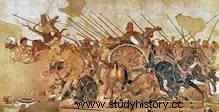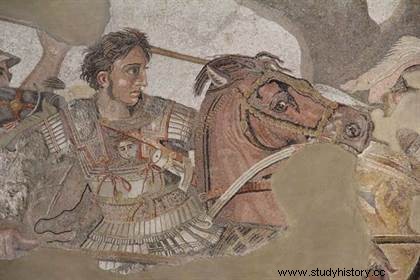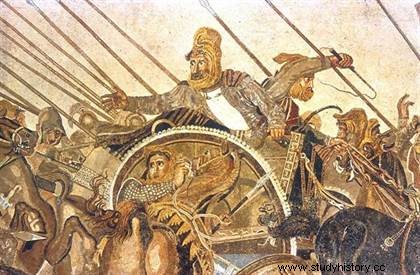 Found in the House of the Faun of Pompeii, where it decorated the floor of a small room, the mosaic of the Battle of Issus is now kept in the Naples Museum. A magnificent work, it has also become a classic in the teaching of art history for sixth graders, as part of the study of Alexander the Great , because it depicts the king of Macedonia and his most famous enemy, Darius, while showing the weapons used by the Greek, and which led to his victory.
Found in the House of the Faun of Pompeii, where it decorated the floor of a small room, the mosaic of the Battle of Issus is now kept in the Naples Museum. A magnificent work, it has also become a classic in the teaching of art history for sixth graders, as part of the study of Alexander the Great , because it depicts the king of Macedonia and his most famous enemy, Darius, while showing the weapons used by the Greek, and which led to his victory.
The Battle of Issus
Even if, according to some interpretations, the mosaic could represent the battle of Gaugamela, the majority of specialists believe that it is rather that of Issos. In 333 BC. J-C, Alexander embarked for a year in the conquest of Asia dominated by the Persians. Learning of the arrival of the king of Persia, Darius, in Cilicia, the Macedonian goes to meet him and forces him to confront him near Issus. The battle pits nearly 40,000 Greeks against more than 100,000 Persians and allies (including Greek mercenaries). These admittedly impressive figures seem to have relatively consensus among historians, and they are above all well below the ancient sources, which evoke between 400,000 and 600,000 Persian fighters, which is obviously a desire to amplify the triumph of Alexander.
The battle is primarily an infantry confrontation, with the Macedonian side the famous phalanx and its 6-meter sarisses. It would then seem that Alexander wanted to face Darius in single combat. But the Persian king preferred to flee the battlefield when he saw his army disintegrate; he even gave up his royal regalia. The Macedonian pursues him for a while before turning back. 
With this victory, Alexander opens the gates of Egypt. Two years later, he faced Darius one last time at Gaugamela, for a definitive victory over the Persian Empire.
The mosaic of the battle of Issos
Dating from the 2nd century BC. J-C, the mosaic was found in a wealthy house in Pompeii, where it decorated the floor. Its author remains anonymous. It would be inspired by a painting by Philoxenos of Eretria, dating from around 300 BC. J-C. Of substantial size (5.12 m by 2.71 m), composed of more than two million "tesserae", it depicts the debacle of Darius against Alexander.
The overall impression given by the work is one of tragedy, a sense of tumult and panic, especially in the way Darius is portrayed. The Persian king is indeed on the run in his chariot, but turned towards his men whose ranks have been broken by Alexander's army. On his face, an expression of fear and helplessness.
Conversely, Alexander is represented as a calm and impassive fighter, mounted on his horse Bucephalus, and charging at the Persians, going so far as to pierce a soldier with his spear. We note that he wears armor decorated with the effigy of Medusa, a mythological character who petrified his victims. The Macedonian king is thus well placed in the line of heroes from whom he is inspired, such as Achilles. 
The mosaic also tells us about the equipment of the armies of the time. We see the weapons, armor, chariot and cavalry horses of both sides, but especially the great Macedonian spears (sarisses), the main weapon of the phalanxes which made Alexander's success throughout Asia.
Finally, the work bears witness to the posterity of the Alexander epic. Characteristic of Hellenistic art in its realism, it decorated a Roman house two centuries after the events it relates.
